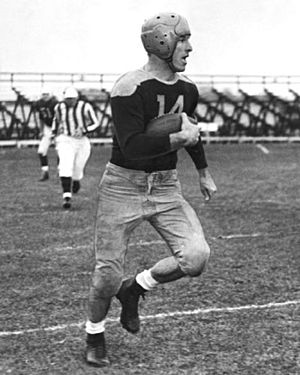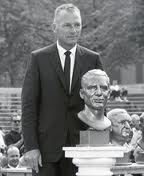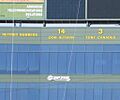Don Hutson facts for kids
 |
|||||||||||||
| No. 7, 14 | |||||||||||||
|---|---|---|---|---|---|---|---|---|---|---|---|---|---|
| Position: | End | ||||||||||||
| Personal information | |||||||||||||
| Born: | January 31, 1913 Pine Bluff, Arkansas |
||||||||||||
| Died: | June 26, 1997 (aged 84) Rancho Mirage, California |
||||||||||||
| Height: | 6 ft 1 in (1.85 m) | ||||||||||||
| Weight: | 183 lb (83 kg) | ||||||||||||
| Career information | |||||||||||||
| High school: | Pine Bluff (AR) | ||||||||||||
| College: | Alabama | ||||||||||||
| Career history | |||||||||||||
| As player: | |||||||||||||
|
|||||||||||||
| As coach: | |||||||||||||
|
|||||||||||||
| Career highlights and awards | |||||||||||||
|
|||||||||||||
| Career NFL statistics | |||||||||||||
|
|||||||||||||
|
Pro Football Hall of Fame
|
|||||||||||||
|
College Football Hall of Fame
|
|||||||||||||
Donald Montgomery Hutson (born January 31, 1913 – died June 26, 1997) was an amazing American professional football player. He was also an assistant coach in the National Football League (NFL). Don Hutson played as an "end," which is like a wide receiver today. He spent his entire 11-year career with the Green Bay Packers.
Under coach Curly Lambeau, Hutson helped the Packers win three NFL Championships. These wins were in 1936, 1939, and 1944. He joined the Packers in 1935 and played until 1945. He led the league in receiving yards seven times and in receiving touchdowns nine times.
Hutson was also a great defensive player as a safety. He even led the NFL in interceptions in 1940. He was chosen as an All-Pro player eight times. He was also named the NFL Most Valuable Player twice.
Many people think Hutson was the first modern wide receiver. He even created many of the pass routes that NFL players still use today. He was the best receiver of his time. He was the first NFL player to gain 1,000 receiving yards in a season. When he retired, he held almost all major receiving records. This included career catches, yards, and touchdowns.
Don Hutson is a member of both the College Football Hall of Fame and the Pro Football Hall of Fame. The Packers honored him by retiring his number 14 jersey. This was the first jersey the team ever retired. He is also in the Green Bay Packers Hall of Fame. Hutson was chosen for the NFL's 50th, 75th, and 100th Anniversary All-Time Teams. This shows how great he was throughout NFL history.
Contents
Early Life and College Football
Don Hutson was born in Pine Bluff, Arkansas, on January 31, 1913. He was one of three sons. As a teenager, he played baseball for his hometown team. In high school, he was an all-state basketball player. He said basketball was his favorite sport.
Hutson played football as an "end" for the Alabama Crimson Tide team. This was from 1932 to 1934. Bear Bryant, who later became a famous coach, played with Hutson. Bryant once said he used to hitchhike just to watch Hutson play. He saw Hutson catch five touchdown passes in one high school game.
In 1934, Hutson's Alabama team was undefeated. Sportswriters called them one of the best teams ever. Hutson was known for his smooth moves and clever fakes. He was also great at catching the ball. He and teammate Dixie Howell were a famous passing duo. In the 1935 Rose Bowl, Hutson had six catches for 165 yards. He scored two touchdowns in that game. He also scored the winning touchdown against the Tennessee Volunteers.
Hutson was named an All-American in 1934. This means he was one of the best college players in the country. He was even given a special award for 1934, like a Heisman Trophy, before the award officially started.
NFL Career with the Packers
After college, Hutson didn't plan to play professional football. College football was more popular back then. But Green Bay Packers coach Curly Lambeau saw Hutson's talent. He knew Hutson would be perfect for his team's passing game.
In those days, college players could sign with any team. Hutson signed with both the Packers and the Brooklyn Dodgers. The NFL president decided Hutson would go to Green Bay. This was because the Packers' contract had an earlier date. Hutson said he chose the Packers because they offered the most money. He got $300 a game, which was a lot for that time.
Becoming a Star Receiver
Hutson's first catch as a professional was amazing. It was an 83-yard touchdown pass in his second game in 1935. This was the only score in the game, and the Packers won 7–0. He caught six touchdowns in his first season. This led the league. He would lead the league in touchdown catches nine times in his career.
In 1936, the Packers won the NFL Championship. Hutson scored the first touchdown in that game. He finished the season with 34 catches for 536 yards and eight touchdowns. These were all new league records.
In 1939, Hutson again led the Packers to the championship game. They won 27–0 against the New York Giants. In 1940, Hutson broke the record for career touchdown passes. He held this record for almost 50 years.
In 1941, Hutson became the first receiver to catch 50 passes in a season. He led the league in catches, receiving yards, and touchdowns. After this great season, he was named the NFL's Most Valuable Player.
He won the MVP award again in 1942. He broke even more records that year. He caught 74 passes for 1,211 yards and 17 touchdowns. This was the first time a receiver gained over 1,000 yards in a season. His amazing play helped his quarterback, Cecil Isbell, throw for over 2,000 yards.
Hutson briefly retired in 1943 due to an injury. But he came back to play that same season. He led the league in catches, yards, and touchdowns again. He even threw his only career touchdown pass that year. He also kicked 36 extra points without missing.
He returned again in 1944 and led the league in receiving. He also served as an assistant coach. The Packers won their third championship with Hutson that year. He retired for the third time but came back to play in 1945. In one game, he set an NFL record with four touchdown catches in a single quarter. He also scored 29 points in that quarter, which is still a record today.
In total, Hutson caught 488 passes for 7,991 yards and 99 touchdowns. He also scored touchdowns by running and returning blocked punts. He scored at least six receiving touchdowns in all 11 of his seasons. He led the NFL in receptions eight times and in receiving yards seven times. He also led the league in scoring five times.
Hutson invented many pass routes that are still used today. One example is the "chair route." He was very hard to defend because no one had seen a player like him before. He almost always found a way to get open. He played in an era where defenders could hit receivers more often. But Hutson was still able to beat them. He never missed a game due to injury in his 11-year career.
Defense and Special Teams
For many seasons, Hutson was also the Packers' kicker. He made 172 extra points and seven field goals. This added up to 823 points, which was another league record. Like most players of his time, Hutson played both offense and defense. On defense, he played safety. He intercepted 30 passes in his career. In 1940, he led the NFL with six interceptions.
Hutson was a player-coach during his last two seasons. After he stopped playing, he stayed on the Packers' coaching staff until 1948.
Life After Football
Don Hutson was always interested in business. While in college, he even ran a laundromat with Bear Bryant. In Green Bay, he opened a bowling alley. It was so successful that he thought about leaving football to focus on it. Later, he started a car dealership. He also served on the Packers' board of directors for many years.
Don Hutson passed away on June 26, 1997, at the age of 84. He lived in Rancho Mirage, California.
Honors and Recognition
Don Hutson has received many honors. He was one of the first people inducted into the Wisconsin Athletic Hall of Fame in 1951. He was also an initial member of the Alabama Sports Hall of Fame in 1968. His number 14 jersey was the first ever retired by the Packers. This happened in a ceremony in 1951.
A street in Green Bay is named after him. In 1994, the Packers named their indoor practice facility the "Don Hutson Center."
Hutson was a charter member of both the College Football Hall of Fame (1951) and the Pro Football Hall of Fame (1963). He is also in the Green Bay Packers Hall of Fame. There is a park named after him in his hometown. He even performed the coin toss at Super Bowl XXII on his 75th birthday.
Hutson was named to the NFL's 1930s All-Decade Team and 50th Anniversary Team. In 1994, he was on the NFL 75th Anniversary All-Time Team. In 1999, The Sporting News ranked him sixth on their list of the 100 Greatest Football Players. He was the highest-ranked Packer and the highest-ranked player from before World War II. In 2012, the NFL Network called Hutson the greatest Green Bay Packer ever.
In 2005, a rare jersey worn by Hutson was donated to the Green Bay Packers Hall of Fame. It was found in a trunk of old uniforms.
Some people wondered if Hutson's records were helped by World War II. Many talented players were serving in the military then. But former Packers player Paul Hornung said Hutson would be just as great today. Hutson was able to avoid military service because he had three daughters.
NFL Records
As of 2017, Don Hutson still holds several NFL records:
- Most seasons leading the league in pass receptions (8)
- Most consecutive seasons leading the league in pass receptions (5)
- Most seasons leading the league in pass receiving yards (7)
- Most consecutive seasons leading the league in pass receiving yards (4)
- Most seasons leading the league in pass receiving touchdowns (9)
- Most seasons leading the league in total touchdowns (8)
- Most consecutive seasons leading the league in pass receiving touchdowns (5)
- Most seasons leading the league in scoring (5, now tied)
- Most consecutive seasons leading the league in scoring (5)
Sportswriter Zipp Newman called Hutson the "Ty Cobb of the gridiron." This means he was like the baseball legend Ty Cobb, who was known for his amazing hitting.
When he retired, Hutson held these records:
- Most touchdowns scored in a quarter: 4
- Most touchdown receptions in a quarter: 4
- Most points scored in a quarter: 29
- Most receptions, career: 488
- Most receptions, season: 74
- Most receptions, game: 14
- Most receiving yards, career: 7,991
- Most receiving yards, season: 1,211
- Most receiving yards, game: 209
- Most receiving touchdowns, career: 99
- Most touchdowns, season: 17
- Most touchdowns, game: 4
- Most points scored in a calendar month: 74 (in October 1945)
Images for kids
-
Don Hutson's number 14 jersey displayed at Lambeau Field




